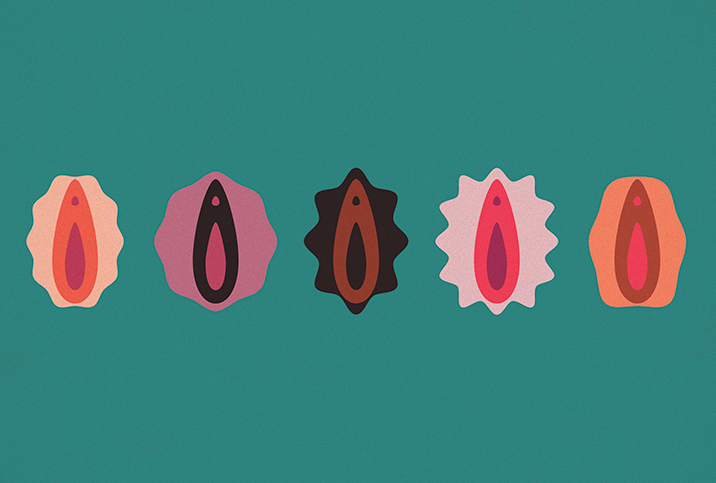Is There Such a Thing as a ‘Loose’ Vagina?

Let's get it straight: there is no such thing as a "loose" vagina. While childbirth and aging can weaken your vaginal muscles, no number of sexual partners can "loosen" your vag. And by the way, while we're stomping on myths, no one can tell how much sex you've had by the way your vagina feels.
So, with that out of the way, where exactly did this idea come from?
The concept of a "loose" woman appears to have originated centuries ago when sexually explorative (or unfaithful) women were considered to have "loose" morals. As is often still the case today, women's bodies and morality were intrinsically linked. And at some point, it seems people may have begun to take the term literally: vaginal tightness could indicate "purity," while less elasticity equaled promiscuity.
Debunking this misconception requires only a basic anatomy lesson.
Vaginas are elastic. Like a hair scrunchie, vaginal muscles can stretch to accommodate penises, sex toys and babies. Usually, they return to their prior tension and shape naturally over time.
However, while penetrative sex does not affect elasticity long-term, no matter how many partners you have, some other factors can. Still, the change is not always irreversible. Vaginas can snap back. Some just require a little more encouragement and TLC than others to do so.
Why do vaginas sometimes feel loose?
Just as penises come in all shapes and sizes, some vaginas are less elastic or more "open" than others. No two bodies are identical, so sex with a new partner may feel different. Sexual position can affect sensation, too.
"Vaginas feel looser or tighter because they are looser or tighter…Everybody has different anatomy," explained Laura Purdy, M.D., lead physician at Wisp. "A vagina is a cavity, and it can be bigger, or it can be smaller, and it can have a lot of muscle tone, or it can have less muscle tone. It can be very elastic, or it can be inelastic. Everybody is different."
"It is okay to have variations between people's bodies, and it is absolutely true that factors, such as age, menopause and childbirth affect the vaginal tissue," she continued. "It is a mucous membrane, and it responds to trauma just like any other area of the body."
Dee Woodcock, a pelvic health physiotherapist, said she frequently works with clients who feel their vagina has lost elasticity, a change that can bring about "physical, functional, and psychological consequences."
'It is okay to have variations between people's bodies, and it is absolutely true that factors, such as age, menopause and childbirth affect the vaginal tissue.'
"It's a body change, and whilst it varies in individuals, it is a natural process," she said. "It is a common health issue that women are reluctant to talk about."
As for why the idea of vaginal tightness persists, Woodcock said social media and porn might skew people's perspectives of what is "normal" or desirable.
"Learning to love our bodies is a discussion in itself," she said.
While some women may worry about the looseness of their vagina, the opposite is true as well. Vaginal tightness can be a legitimate health condition, especially if it's causing pain or discomfort during penetrative sex.
The vagina relaxes, self-lubricates and stretches during arousal. That won't happen if you're not in the mood or have an underlying condition, such as vaginismus.
Does childbirth cause vaginas to become loose?
During vaginal delivery, the vaginal muscles stretch to accommodate the baby. The muscles gradually regain tautness most of the time, although they're unlikely to feel the same postpartum.
Childbirth can also weaken the pelvic floor muscles and damage the skin and tissues, causing long-lasting changes.
"Childbirth can cause a variety of issues such as pelvic floor muscle weakness, scar tissue after tears or episiotomy, pain, etc.," said Myra Robson, pelvic health physiotherapist, clinical lead, and co-founder of Pelvic Roar.
People who have had multiple vaginal births are more likely to have weaker vaginal muscles.
Does my vagina become loose as I get older?
Like other muscles and bodily systems, the pelvic floor muscles can weaken with age, even in people who have never given birth. Changes usually begin around age 40, when estrogen levels decline and perimenopause begins.
An estrogen decrease can make the vaginal tissues thinner, less acidic, drier and less flexible. These symptoms compound with the onset of full menopause.
"There will be a very minimal reduction in tissue elasticity with age, but hardly noticeable to most people. A reduction in estrogen at menopause or with breastfeeding can also make tissues a little less bouncy," Robson explained.
How can ensure my vagina is never loose?
For most women, the slight variations in your vagina tissue won't be noticeable during sex. If you've had multiple children, however, you may notice a small difference in the elasticity of your vaginal muscles. In that case, you want to focus on strengthening your pelvic floor.
Woodcock said pelvic floor retraining is the primary treatment she recommends for people with pelvic floor dysfunctions, including the sensation of vaginal laxity.
The pelvic floor muscles sit at the base of the pelvis, supporting the uterus, bladder, and bowels. These are the muscles used to prevent urination or flatulence; they're also the muscles that contract during orgasm.
"The pelvic floor muscles (PFM) are responsible for supporting the pelvic contents. Imagine a boat in a dock (uterus, vagina, bladder, bowel)—floating gently on the water (pelvic floor muscles). Supported and no tension. Take the water away, and the boat will drop," Woodcock described.
"This is not my analogy but is widely described when educating women during pelvic health consultations," she continued. "Strengthening and therefore increasing bulk of pelvic floor muscles can increase sensation during intimacy."
Such exercises include Kegels and pelvic tilts. Vaginal cones are another option that involves inserting a tampon-size weight into the vagina and using the muscles to hold it in place for 15 minutes.
The Mayo Clinic recommends using this technique to do Kegels:
- First, identify your pelvic floor muscles by stopping your urine midstream.
- Once you understand where your muscles are, you can choose a position, either sitting or lying on your back. Many people prefer the latter.
- Tighten the pelvic floor muscles and hold the contraction for five seconds. Rest for five seconds and repeat. If it helps, imagine you're sitting on a marble and lifting that marble as you tighten.
- Be careful not to flex the abdomen, thighs, or buttocks as you tighten; focus on the pelvic floor muscles only. Don't hold your breath.
- Repeat these exercises two or three times a day with 10 to 15 sets of repetitions each time.
To perform pelvic tilts, try this:
- Stand with your shoulders and buttocks against the wall, keeping your knees relaxed.
- Draw your navel in toward your spine, so your back lies flat against the wall.
- Hold this position for four seconds, then relax.
- Repeat 10 times up to five times daily.
Beyond pelvic floor muscle training, there are additional options for treating vaginal tissue loss.
Purdy said there are "lots and lots of options," including neuromuscular electrical stimulation (NMES), which is designed to create biofeedback and increase muscle tone. There are also injections and radiofrequency procedures to promote tissue regrowth.
While they don't affect elasticity per se, estrogen creams can improve sensation by lubricating the tissues and making them more supple.
The Bottom Line
If you're unhappy with the sensation you're getting during sex, there are options. Consider switching positions, doing pelvic floor strengthening exercises or working with a doctor or physiotherapist.
However, it's important to remember vaginas are as individual as we are. They're also just as resilient. But they're not impervious to the effects of trauma, age or other factors—and some degree of change over time is to be expected.


















